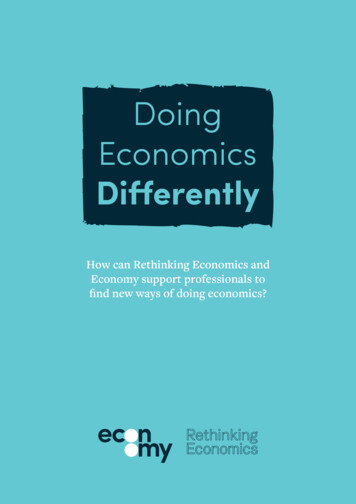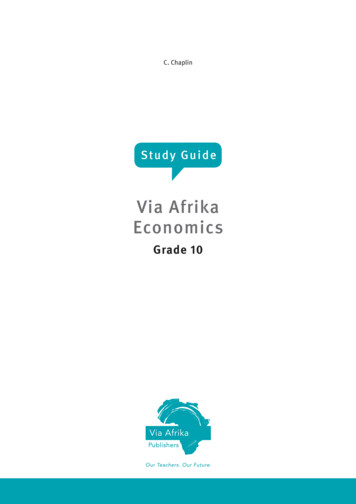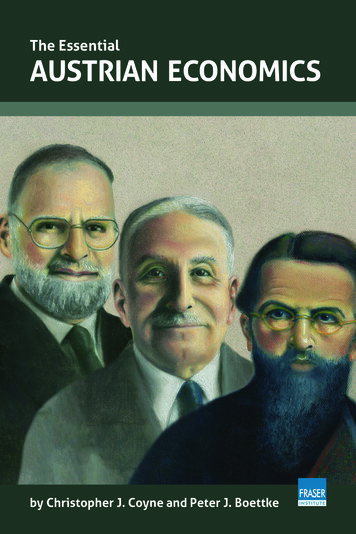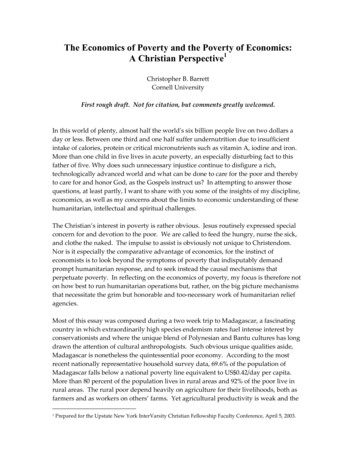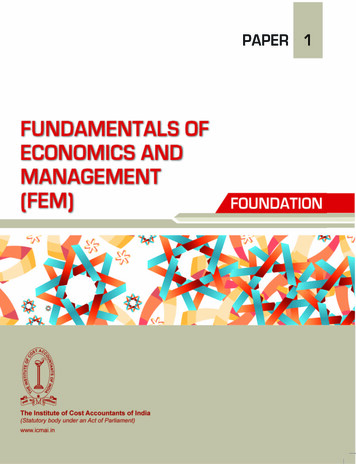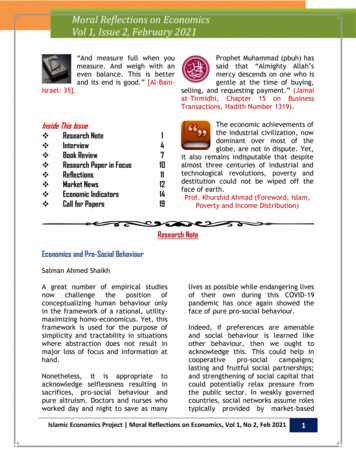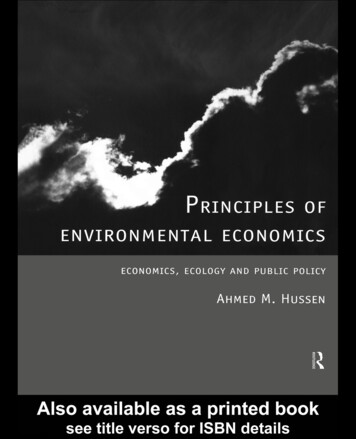
Transcription
PRINCIPLES OF ENVIRONMENTAL ECONOMICSThis text offers a systematic exposition of environmental and natural resource economics. It presents theeconomic and ecological principles essential for a clear understanding of contemporary environmental andnatural resource issues and policy considerations. Environmental and natural resource issues are consideredin a broad, interdisciplinary context that does not treat them as just another subset of applied economics.The main subject areas include: basic economic concepts specifically relevant to environmental economicsthe economics of natural resource scarcityecology, economics and the biophysical constraints to economic growthecological economicsthe economics of sustainable developmentthe economics of pollutionvaluing the environmentthe economics of natural resourcespopulation, development and the environmentThe author develops specific tools to illuminate the central problems of environmental economics.Fundamental economic concepts specifically relevant to environmental and resource economics areintroduced and then integrated with ecological principles and approaches. This text presents an integratedunderstanding of environmental and resource economics that acknowledges the disciplinary tie betweeneconomics and ecology.This student-friendly textbook contains a variety of study tools including learning points, boxed features,case studies, revision questions and discussion questions. Written in a clear and accessible style, Principlesof Environmental Economics considers a variety of real-world examples to illustrate the policy relevanceand implications of key economic and ecological concepts.Ahmed M.Hussen is a Professor and Chair of the Department of Economics, Kalamazoo College,Michigan, USA.
PRINCIPLES OFENVIRONMENTAL ECONOMICSEconomics, ecology and public policyAhmed M.HussenLONDON & NEW YORK
First published 2000 by Routledge11 New Fetter Lane, London EC4P 4EEThis edition published in the Taylor & Francis e-Library, 2005.“To purchase your own copy of this or any of Taylor & Francis or Routledge’s collection of thousands of eBooks please go towww.eBookstore.tandf.co.uk.”Simultaneously published in the USA and Canadaby Routledge29 West 35th Street, New York, NY 10001 2000 Ahmed M.HussenAll rights reserved. No part of this book may be reprinted orreproduced or utilized in any form or by any electronic,mechanical, or other means, now known or hereafter invented,including photocopying and recording, or in any informationstorage or retrieval system, without permission in writingfrom the publishers.British Library Cataloguing in Publication DataA catalogue record for this book is available from the British LibraryLibrary of Congress Cataloging in Publication DataHussen, Ahmed M.Principles of environmental economics: economics, ecology andpublic policy/Ahmed M.Hussen.p. cm.Includes bibliographical references and index.1. Environmental economics. 2. Ecology. 3. Environmental policy.I. Title.HC79.E5H875 1999333. 7–dc21 99–17809CIPISBN 0-203-45581-9 Master e-book ISBNISBN 0-203-76405-6 (Adobe eReader Format)ISBN 0-415-19570-5 (hbk)ISBN 0-415-19571-3 (pbk)
ContentsFiguresxiiiTablesxvCase xiiiIntroductionpart oneTHE ªPREANALYTICº VI SION OF NATURALRESOURCES: THESTANDARD ECONOMIC PERSPECTIVE1xxv1The concept of resources and resource scarcity: an economic perspective2Learning objectives21.1Introduction21.2The concept of resources31.3Scarcity and its economic implications41.4A schematic view of the economic process51.5Applying the concept: ecotourism, cattle ranching and the economy of Costa Rica81.6Chapter summary10Review and discussion questions11part twoMARKETS, EFFICIENCY, TECHNOLOGY AND ALTERNATIVEECONOMIC INDICATORS OF NATURAL RESOURCE SCARCITY22.113Resource scarcity, economic efficiency and markets: how the invisible handworks14Learning objectives14Introduction14
v2.2Basic assumptions152.3An interpretative analysis of demand, supply and market equilibrium price162.4Evaluating the performance of a perfectly competitive market �� surplus and net social benefit242.4.3Pareto optimality and the Invisible Hand Theorem252.5Product price as a measure of natural resource scarcity262.6Chapter summary31Review and discussion questions32Market signals of natural resource scarcity: resource price, rent andextraction cost34Learning objectives343.1Introduction353.2The demand for a factor of production: the case of natural resources353.3Key variables affecting the supply of a factor of production: the case of naturalresources373.4Long-run market valuation of a factor of production393.5Rent and extraction cost as alternative measures of natural resource scarcity4033.5.1Differential rent413.5.2Extraction cost443.6Factor substitution possibilities, technological changes and resource scarcity443.6.1Factor substitution443.6.2Changes in production technology: technical advances463.7Important caveats483.8Chapter summary49Review and discussion questions50part threeECOLOGY: THE ECONOMICS OF NATURE452The concept of natural resources: an ecological perspective53Learning objectives534.1Introduction544.2Ecosystem structure54
vi4.3Ecosystem function554.3.1Materials recycling564.3.2Succession, equilibrium, stability, resilience and complexity574.4The laws of matter and energy604.5The basic lessons of ecology624.6Humanity as the breaker of climaxes634.7Chapter summary67Review and discussion questions68part fourFUNDAMENTALS OF THE ECONOMICS OF ENVIRONMENTALRESOURCES5The market, externality, and the ªoptimalºquality and economic goodstrade-offbetween environmental7071Learning objectives715.1Introduction725.2The economic process and the assimilative capacity of the natural environment735.3Common property resources, external costs and market failure765.3.1Common property resources and the economic problem765.3.2Environmental externalities and their economic consequences785.4Internalizing externality using the Pigouvian tax approach825.5The macroeconomic effects of environmental regulations: an overview855.6Chapter summary87Review and discussion questions88part fiveTHE PERENNIAL DEBATES ON THE BIOPHYSICAL LIMITATIONS TOECONOMIC GROWTH691Biophysical limits to economic growth: the Malthusian perspective92Learning objectives926.1Introduction926.2The simple Malthusian growth doctrine: population and resource scarcity936.3Modified Malthusian models: population, resource use and environmental quality966.3.1Population and its impact on resource utilization and environmental quality97
vii6.3.2Per capita consumption and its influence on the 6.3.3Technology and its influence on the 6.3.4The basic lessons of the Ehrlich-Commoner model1026.4Has Malthus been discredited?1036.5Chapter summary105Review and discussion questions105Biophysical limits to economic growth: the neoclassical economic perspective108Learning objectives1087.1Introduction1097.2Resource scarcity, technology and economic growth1097.3The classical doctrine of increasing resource scarcity: the empirical evidence1117.4Emerging resource scarcity or abundance: the recent evidence1147.5Economic growth, the environment and population: the neoclassical perspective1177.6Chapter summary119Review and discussion questions120Biophysical limits to economic growth: the ecological economics perspective123Learning objectives1238.1Introduction1248.2Ecological economics: nature and scope1248.3The development of ecological economics: a brief historical sketch1268.4Biophysical limits and their implications for economic growth: an ecologicaleconomic perspective129788.4.1Kenneth Boulding (1909–93): ecological limits1298.4.2Nicholas Georgescu-Roegen (1906–94): energy as a limiting factor1308.4.3Herman Daly: the steady-state economy1328.59Chapter summary139Review and discussion questions140The economics of sustainable development142Learning objectives142
viii9.1Introduction1439.2Sustainable development: a helpful term or a vague and analytically empty concept?1449.3The Hartwick-Solow approach to sustainability1469.4The ecological economic approach to sustainability1509.5The safe minimum standard (SMS) approach to sustainability1539.6Sustainable national income accounting1549.7Chapter summary157Review and discussion questions158part sixTHE ECONOMICS OF ENVIRONMENTAL RESOURCES: PUBLICPOLICIES AND COST-BENEFIT ESTIMATIONS OF ENVIRONMENTALDAMAGE161The economic theory of pollution control: the optimal level of pollution162Learning objectives16210.1Introduction16210.2Minimization of waste disposal costs16310.2.1Pollution control (abatement) costs16310.2.2Pollution damage costs1651010.3The optimal level of pollution16810.4Changes in preference and technology and their effects on the optimal level ofpollution17110.5An alternative look at market failure17210.6The optimal level of pollution: an ecological appraisal17310.7Chapter summary177Review and discussion questions178The economics of environmental regulations: regulating the environmentthrough judicial procedures180Learning objectives18011.1Introduction18011.2Environmental regulation through liability laws18111.3The property rights or Coasian approach18411.4Emission standards18711
ix11.5Chapter summary195Review and discussion questions196The economics of environmental regulations: pollution tax and markets forpollution permits198Learning objectives19812.1Introduction19812.2Effluent charges19912.3Transferable emission permits20412.4An evaluation of the emission trading programs in the United States2091212.4.1Programs to phase out leaded gasoline and ozone-depleting chlorofluorocarbons(CFCs)20912.4.2The acid rain control program21012.5Chapter summary213Review and discussion questions214Global environmental pollution: acid rain, ozone depletion and globalwarming216Learning objectives21613.1Introduction21613.2Causes and consequences of acid rain21713.3Causes and consequences of depletion of the ozone layer21813.4Causes and consequences of global warming21913.5International responses to acid rain, ozone depletion and climate change22013.6The economics of atmospheric pollution22413.7Chapter summary227Review and discussion questions228The economic theory and measurement of environmental damage (benefit):valuing the environment231Learning objectives23114.1Introduction23214.2Valuation of benefits: the methodological issue23314.3Practical methods of measuring the benefits of environmental improvement235131414.3.1The market pricing approach236
x14.3.2The replacement cost approach23714.3.3Hedonic price approaches23714.3.4The household production function approach23914.3.5The contingent valuation method24114.4Some general problems associated with the economic approach to environmentalvaluation24614.5Chapter summary249Review and discussion questions251A framework for assessing the worthiness of an environmental project: costbenefit analysis254Learning objectives25415.1Introduction25515.2The welfare foundation of cost-benefit analysis25615.3The net present value criterion25715.4Private versus public project appraisal25815.5Discounting and intergenerational equity26315.6Chapter summary264Review and discussion questions26515part sevenBASIC ELEMENTS OF THE ECONOMIC THEORIES OF RENEWABLE ANDNONRENEWABLE RESOURCES268Fundamental principles of the economics of renewable resources: the case offishery269Learning objectives26916.1Introduction27016.2The natural growth function of biological resources27016.3General characteristics of the natural growth function of fishery populations27216.4The production function of fishery: a steady-state bioeconomic equilibrium model27416.5Economics of fisheries management27916.5.1The open-access equilibrium yield28016.5.2The socially optimal level of effort under private property rights2811616.6Regulation of fishery: an overview283
xi16.7Some important limitations of the steady-state bioeconomic model28616.8Chapter summary289Review and discussion questions290Fundamental principles of the economics of nonrenewable resources293Learning objectives29317.1Introduction29417.2Assessment of natural resource stocks2951717.2.1Reserves, resources and resource bases29517.2.2A measure of resource adequacy: reserve-to-use ratio29717.2.3The hypothesis of smooth tonnage grade29717.3The optimal intertemporal allocation of nonrenewable resources29917.3.1Basic assumptions and preliminary analyses29917.3.2The general condition for optimal intertemporal allocation of nonrenewable andnonrecyclable resources30017.3.3The optimal intertemporal allocation of nonrenewable but recyclable resources30317.3.4Further reflections on the nature of the user cost and some public policyimplications30417.4The optimal price and extraction paths of nonrenewable resources30717.4.1The time path of nonrenewable resource prices30817.4.2The optimal price path and resource exhaustion31017.5Resource prices and extraction rates in the less than perfect world31117.6Resource exhaustion, backstop technology and limits to growth31317.7Chapter summary315Review and discussion questions316part eightRESOURCE SCARCITY, POPULATION, POVERTY AND THEENVIRONMENT18318Population, development and environmental degradation in the developingworld319Learning objectives31918.1Introduction32018.2Growth trends and spatial distribution of global population: a historical perspective321
xii18.3Population control policy: in theory and practice32418.3.1The theory of the demographic transition32518.3.2The microeconomic theory of human fertility32618.3.3Population control through economic incentives32818.4Economic development, population, poverty and environmental degradation32918.5Chapter summary334Review and discussion questions336Index338
16.26.37.17.28.19.110.1Circular flow diagram of the economic processThe production possibility frontier for Costa RicaA market demand curveA shift in market demand curveA market supply curveA shift in market supply curveHow the market gravitates toward equilibriumLong-run market equilibrium priceConsumers’ surplusProducers’ surplusPareto optimalityRoles of market priceLong-run price trendThe market demand for coalMarket conditions in the electricity industryMarket conditions in the coal industryMarket supply of coalLong-run equilibrium price for coalLong-run price trend for coalThe concept of rentThe case of differential rentFactor substitution possibilitiesAdvances in production techniquesBiased technological advancesEnergy flow and material cycling in an ecosystemEcologically enlightened economic view (full world scenario)A simple relationship between economic ouput and waste dischargeSocial optimum in the presence of externality: the case of the paper industrySocial optimum through a tax on outputA simple Malthusian growth modelEhrlich’s model: the impact of population on the environmentPer capita consumption and its effect on the environmentThe strong hypothesis of increasing natural resource scarcityThe weak hypothesis of increasing natural resource scarcityEnds-means spectrumTrade-offs between intergenerational efficiency and equityMarginal pollution control 5664758183949899112114133146165
7.517.617.717.818.118.218.3Marginal pollution damage costOptimal level of pollutionOptimal level of pollution: a numerical illustrationWhat happens when optimality is not attained?Effect of technological and preference changes on the optimal level of pollutionOptimal level of pollutionA case where a zero level of waste emission is considered optimalMarginal damage and control costs of the paper millGraphical illustration of the Coase theoremEmission standards as a policy tool to control pollutionThe cost-effectiveness of emission standardsEmission standards and the incentive to improve pollution control technologyPollution control through effluent chargesOptimal level of effluent chargeEffluent charge and a firm’s incentive to invest in a new pollution control technologyHow transferable emission permits workDemand and supply curves for environmental goods and servicesDemand for improved air qualityChange in consumers’ surplus as a measure of social benefitDemand for improved air qualityThe choice between conservation and economic developmentThe discount factor when r 0.05The discount factor when r 0.10Natural growth curve for fishery populationThe relationships between harvest, population size and effortA steady-state bioeconomic equilibrium model of fish harvestProduction function of fishery: the sustainable yield curveLong-run total revenue, total cost and fishing effort for a fisherySocially optimal level of fishing effortEffect of a tax on fishing effortEffect of a tax on fish catchThe relation of resources to noneconomic materialsPossible geochemical distribution of abundant and scarce elementsOptimal intertemporal allocation of an abundant nonrenewable resourceOptimal intertemporal allocation of a nonrenewable and nonrecyclable resourceEffect of recycling on marginal user costTime path of the price of a nonrenewable resourcePrice and extraction paths for nonrenewable resourcesBackstop technologyPast and projected world populationThe demographic transitionDemand and supply curves for 5296298300301304310311314322325327
Tables4.19.111.114.116.118.118.218.318.4Nature’s ecosystem servicesHow green is your country?Some of the major environmental laws enacted by the United States Congress, 1938–90Total annual consumer surplus (US ) from recreation use and preservation value toColorado households from increments in wilderness designation, Colorado, 1980Examples of precautionary measuresApproximate time taken for the world’s population to grow by a billionWorld population growth by decade 1950–90 with projections to 2000Annual rates of population growth (as percentages) by regions, 1950–85Population trends, 1900–2000 (millions)63156187246288321323323323
Case 7.118.1Economic returns from the biosphereRanching for subsidies in BrazilThe economic impact: the 1990 Clean Air Act amendmentsAsset recycling at XeroxSustainable forest management practice: the case of the Menominee IndianReservationHabitat preservation of endangered fish species in the Virgin River systems: anapplication of the safe minimum standard approachEconomic effects of poor indoor air qualityPurchasing pollutionEconomics and the Endangered Species ActEconomics and the Endangered Species Act: costs of species protectionThe roots of overfishingOverreacting to overcapacityMining the earthCommunal tenure in Papua New Guinea42986135151153166207242259282285305332
.111.211.312.114.1Ecotourism, forestland preservation and the economy of Costa RicaPerpetual motion, a sort of “original sin” in scienceThe Irish potato famineThailand’s shrimp boom comes at great ecological costWhat is the most desirable level of pollution?Feeding the world: less supply, more demand as summit convenesBeyond ShivaResources, population, environment: an oversupply of false bad newsEnergyFalling birth rates signal a different world in the makingCarrying capacity and ecosystem resilienceWhat will happen to Saudi Arabia when its oil reserves are eventually exhausted?An ounce of pollution prevention?Ore-Ida Foods to pay 1 million for polluting Snake RiverEmission standards proposed for marine enginesEPA proposes strict new air quality standardsAcid rain emission limits proposed for over 900 power plantsToward ecological 5248
PrefaceThe primary objective of this book is to present the economic and ecological principles essential for a clearunderstanding of the complex contemporary environmental and natural resource issues and policyconsiderations. Several textbooks have been written on this subject in recent years. One may ask, then, whatexactly differentiates this one from the others?LEVELThis book is written for an introductory-level course in environmental and resource economics. It isprimarily designed for college sophomores and juniors who want to study environmental and resourceconcerns with an interdisciplinary focus. The academic majors of these students could be in any field ofstudy, but the book would be especially appropriate for students with majors in economics, politicalscience, environmental studies or biological sciences.Several other textbooks may claim to have the above-stated features. However, very few, if any, offer twochapters that are exclusively designed to provide students with fundamental economic concepts specificallyrelevant to environmental and resource economics. In these chapters, economic concepts such as demandand supply analysis, willingness to pay, consumers’ and producers’ surplus, rent, marginal analysis, Paretooptimality, factor substitution and alternative economic measures of scarcity are thoroughly andsystematically explained. The material in these two chapters (Chapters 2 and 3) is optional. They areintended to serve as a good review for economics students and a very valuable foundation for students witha major in a field other than economics. This book requires no more than a semester course in microeconomics.Thus, unlike many other textbooks in this field, it does not demand a knowledge of intermediate microeconomics, either implicitly or explicitly.The claim that environmental and resource economics should be studied within an interdisciplinarycontext is taken very seriously. Such a context requires students to have, in addition to microeconomics, agood understanding of the basic principles of the natural and physical sciences that govern the natural world.This book addresses this concern by devoting a chapter to ecology. This is done not only to make certainrelevant ecological principles understandable to non-science students, but also to clearly present thedisciplinary tie between economics and ecology. This chapter assumes no prior knowledge in ecology.Instead, it discusses thoroughly and systematically ecological concepts such as ecosystem, ecosystemstructure, material recycling, the law of matter and energy, entropy, and the interrelationships of succession,stability, resilience and complexity of ecological systems. These are concepts especially pertinent to theunderstanding of biophysical limits and to recent concerns with global issues such as loss of biodiversityand climate change.
xixThis book is primarily a theoretical exposé of environmental and resource economics. The emphasis is ona systematic development of theoretical principles and conceptual frameworks essential for a clearunderstanding and analysis of environmental and resource issues. To catch students’ imagination andattention, as well as to reinforce understandings of basic theoretical principles, case studies and “exhibits”are incorporated into most of the chapters. These are taken from newspaper clippings, brief magazinearticles, articles and summaries of empirical studies from professional journals, and excerpts of publicationsfrom government and private research institutions.ORIENTATIONUnlike other textbooks in this area, this book is written in the belief that a course in environmental andresource economics cannot be treated as just another applied course in economics. It must include botheconomic and ecological perspectives and, in so doing, must seek a broader context within whichenvironmental and natural resource issues can be understood and evaluated. In this regard, the book does notapproach environmental and natural resource problems from only or even predominantly a standard economicperspective.From my experience of nearly two decades of teaching a course in environmental and resourceeconomics, I have come to realize that it is extremely difficult for students to understand and appreciate thesubtle differences between the economic and ecological perspectives until they are made aware of the“axiomatic” foundations (the conceptual starting point of analysis) of each of these perspectives. With thisin mind, this book starts with a careful examination of the preanalytic or axiomatic assumptions of standardeconomic perspectives concerning resources, resource scarcity and the role that natural resources play in theeconomic process. Similarly, the axiomatic assumptions pertaining to the ecological perspective arediscussed in another chapter. Thus, the clear delineation of the anthropocentric and biocentric views ofnatural resources and their scarcity is a unique feature of this textbook.Most texts on environmental and resource economics are neoclassical in their orientation. For this reasonthe emphasis is mainly on intertemporal optimal allocation among alternative uses of the total resourceflow, including the services of the natural environment. In this regard the overriding concern is efficiency.This book does not disregard the importance of this approach, but it adds to it another important dimension:the concern for achieving the optimal scale of total resource flow relative to the environment. The key issuehere is to keep the economic scale within the ecological carrying capacity and this requires the recognitionof biophysical limits. Several chapters are assigned to discuss alternative views on biophysical limits toeconomic growth and the economics of sustainable development. This, as will be evident shortly, is one ofthe most distinguishing features of this book.
xxORGANIZATIONThe book consists of eighteen chapters which are grouped into eight parts, as shown in the diagram. Thefive boxes represent the major organizational themes of the book. As indicated by the direction of thearrows, these five themes or major groupings are related in both specific and general terms. The exactnature of these relationships will become evident from the discussions that follow.Fundamental economic and ecological concepts and perspectivesThe four chapters of Parts One, Two and Three constitute what I consider to be the conceptual starting pointof economic and ecological analyses of natural resources and their scarcity. Chapter 1 deals with the“axiomatic” assumptions that are fundamental to the understanding of the standard economic perception ofnatural resources and their role in the economic process. An early explanation of these assumptions, even ifit does not serve to correct logical errors, helps clarify the position neoclassical economists tend to have onnatural resource issues in general.Chapters 2 and 3 offer comprehensive treatment of all the basic concepts essential for understanding theeconomic approach to natural resource and environmental policy. Furthermore, for the most part this is doneusing no more than the traditional demand and supply analysis. The two chapters are written with three specificobjectives in mind:1 To show how, in general, resources are allocated in a competitive market economy.2 To identify and carefully assess the relative merits of several alternative indicators of emerging naturalresource scarcity.3 To explain the economic arguments on how scarcity of natural resources can be alleviated throughfactor substitution possibilities and/or technological advances. As stated earlier, these two chapters areoptional for students with a strong economic background.
xxiChapter 4 is intended to provide students with basic concepts and principles of ecology, therebyencouraging economics students to venture beyond the realm of their discipline. The position taken here isthat no serious student of environmental and resource economics can afford to be ignorant of the importantlessons of ecology. However, it should be understood that the inquiry on this subject matter is quite focusedand limited. The primary intent is to familiarize students with carefully selected ecological concepts andprinciples so that they will acquire at the end, if not appreciation, a clear understanding of ecologists’perspective of the natural world and its relationship with the human economy. This is also a chapter of vitalimportance to the recognition of the existence of biophysical limits.Environmental externalities and market failurePart Four, which consists of a single chapter, Chapter 5, represents the second organizational theme of thetext. This part covers fundamental concepts in environmental economics. It demonstrates how the basicconcepts in ecology and economics studied in Parts One, Two and Three can be used to help us understandand resolve the problem of environmental pollution. Concepts such as the waste absorptive capacity of theenvironment, externalities, market failures and environmental regulations and their macroeconomic effectsare discussed in this chapter. These are also concepts which are important to understand for the discussionin Part Five .Biophysical limits to economic growthThe four chapters in Part Five are unique in their organization and contain some topics that are rarelydiscussed in standard textbooks on environmental and resource economics. The major concern here is thescale of the economy relative to the natural environment.Chapters 6, 7 and 8 discuss the limit to economic growth from three distinctive perspectives: Malthusian,neoclassical and ecological economics, respectively. Chapter 9 deals with the economics of sustainabledevelopment. The key questions that these four chapters address are:1 Can we expect unlimited economic growth in a world endowed with finite resources?2 If
PRINCIPLES OF ENVIRONMENTAL ECONOMICS This text offers a systematic exposition of environmental and natural resource economics. It presents the economic and ecological principles essential for a clear understanding of contemporary environmental and . This edition



